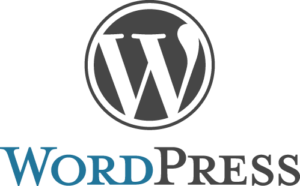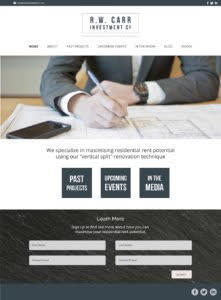The learning curve is sharp when you first become an entrepreneur. One of the biggest hurdles new business owners face is the creation of a website. It’s hard to make good business decisions if you don’t know what you’re paying for, what’s normal, or what to expect. So here are some good guidelines that will let you know what’s normal, and what isn’t.
 MINDSET – Mindset is very important. The process of building a website is less like buying a new car, and more like a home renovation. You may have seen an HGTV home design program where they take down a wall and realize that a project is going to be much more expensive than they thought, or a whole build gets help up because a client can’t decide between marble or slate countertops. This kind of dynamic can also happen in your web build. The project might change in scope, especially if you decide to add new features halfway through the build. Clients can also hold up the project if they can’t make quick decisions about content or layouts. Be prepared that you will have to have a level of involvement in the project, and decisions will be needed from you. But balance that by letting the designers guide the project. They know what can be done easily, and what is going to drive your price up and isn’t worth it in the long run.
MINDSET – Mindset is very important. The process of building a website is less like buying a new car, and more like a home renovation. You may have seen an HGTV home design program where they take down a wall and realize that a project is going to be much more expensive than they thought, or a whole build gets help up because a client can’t decide between marble or slate countertops. This kind of dynamic can also happen in your web build. The project might change in scope, especially if you decide to add new features halfway through the build. Clients can also hold up the project if they can’t make quick decisions about content or layouts. Be prepared that you will have to have a level of involvement in the project, and decisions will be needed from you. But balance that by letting the designers guide the project. They know what can be done easily, and what is going to drive your price up and isn’t worth it in the long run.
CONTENT – You can help the process go smoothly by providing the builder with content:
- your business description,
- product descriptions
- pricing
- calls to action
- plugins you might want (booking software or email opt-ins)
- any images that you want.)
You need to have some time set aside to prepare these things. No web company will know your business as well as you do, so they will need your input. Don’t be too surprised if the developer comes back with recommended changes, or some things don’t look exactly like you requested. There may be limitations to your chosen web templates, or perhaps what you want might cost a lot more than you are prepared to spend. Always ask your designer or developer before you perceive changes as poor customer service.
MOCK-UP – A “mock-up” is often provided that shows you what the layout of your site will look like before it’s built. This is the place where you will want to give feedback and edits. It’s cheaper to fix things at this stage than when the developer has already built it. You may also see your website “unfinished” at several stages. That can be scary because it may look nothing like you expected, but keep the faith. You are working together toward a final reveal that you will love! Also, be conscious that when you APPROVE a mock-up, the team will go forward with work. Coming back with changes after you have given approvals, is like asking a home builder to move the walls around. It may incur more expense. Ask your developer and see if they can accommodate you easily. They will want you to be happy, but you will probably by unhappy if the price goes up.
TIMELINES – Web companies are notorious for going over target dates or taking longer than expected. To a small extent, this is the nature of the industry. Sometimes a glitch that no one expects can occur, and it may take hours to fix a plugin, or find out why something isn’t working on mobile. If your web builder has other clients, flaws in their project may affect your timelines. It’s best to be patient and recognize that the process isn’t perfect, but everyone is usually doing their best. Be honest about your web company about what you need. A good average build time can range from 3 weeks to a month and a half. These timelines can change depending on:
- the complexity of the site
- how clear you were about what you wanted
- how easily you shared content
- whether the developer is starting from scratch or editing something existing
- whether any plugins or features malfunctioned during the build.
Price – Websites can range in price from $500 to $3,000+. At the low end of the price range, you are likely working with a friend of family member, who doesn’t do websites full time – which may be fine if your needs are simple. But be careful! While totally well-intentioned, these people may not be around later when you need passwords or updates. At the mid-range prices $800-$1500 you are probably working with a professional, but certain aspects of your website are probably NOT included, like content writing, images, hosting or extra plugins. These things could vary, so make sure you have a clear agreement with your developer about what you would be responsible for. Websites over $2000 begin to include content writing, very simple e-commerce or additional plugins like booking software or email  sales funnels. It is not unreasonable to expect some SEO set-up at this point. Sites upwards of $3,000 are usually increasingly complex, contain e-commerce, or should include your content writing, images and simple plugins at no additional cost. If you live in a major city or are working with an in-demand niche business, the rates could be higher.
sales funnels. It is not unreasonable to expect some SEO set-up at this point. Sites upwards of $3,000 are usually increasingly complex, contain e-commerce, or should include your content writing, images and simple plugins at no additional cost. If you live in a major city or are working with an in-demand niche business, the rates could be higher.
Service – When you pay hard earned money for something, you expect good service. But be aware that the price point you’ve paid may dictate exactly how MUCH service you get. It is unreasonable to pay less than $1000 for your website, and expect that there will be unlimited edits and revision time, or that your web developer has budgeted multiple in-person meetings, or is open to multiple re-writes or re-designs. All companies should be happy to offer this kind of service to your heart’s content – provided you pay for it. Be a good customer and keep your expectations in line with your budget.
Passwords & Accounts You NEED – You should always have these! Especially if your site was made by an uncle or friend who may be unreliable in the future. A web company may not pass these over until you’ve paid your bill in full, but once you have, make sure that you keep all this information in a memorable location. There are usually THREE passwords that you need to keep track of:
- Your URL – This is your web address. The www.yoursite.com for example. If you bought this, (usually around $20) make sure that you keep the SITE that you bought it from, your username to get into your account, AND the password. You will be billed again in 2-3 years time which is just enough time to lose all your information!
 Your HOSTING – This is the place that STORES your website. It can range from $70-$250/yr. depending on if you include security protections, tech support, and other features. Some companies will want to HOST your site for you, and they will charge you monthly or annually for this. Paying annually usually saves you money. Examples of Hosting companies include GoDaddy and Host Gator. We strongly recommend BlueHost. We don’t usually recommend hosting from the company who builds your site, as they often aren’t large enough companies to offer reliable tech support and service, and it can get awkward personally if you want to move your site later. (You CAN move your hosting by the way!) Get a username and password for your hosting account – it COULD be the same company where you bought your URL, and this is often easiest. A developer might need this password from you to upload site materials, big files, or debug something that is happening in the FILES of your website.
Your HOSTING – This is the place that STORES your website. It can range from $70-$250/yr. depending on if you include security protections, tech support, and other features. Some companies will want to HOST your site for you, and they will charge you monthly or annually for this. Paying annually usually saves you money. Examples of Hosting companies include GoDaddy and Host Gator. We strongly recommend BlueHost. We don’t usually recommend hosting from the company who builds your site, as they often aren’t large enough companies to offer reliable tech support and service, and it can get awkward personally if you want to move your site later. (You CAN move your hosting by the way!) Get a username and password for your hosting account – it COULD be the same company where you bought your URL, and this is often easiest. A developer might need this password from you to upload site materials, big files, or debug something that is happening in the FILES of your website.- Your Website – Finally, if your site is built on WordPress or some of the other common platforms, you will need a username and password that gets you into the BACK END of your website where you can actually edit the content. Your provider should give you all this information, as soon as you pay your bill in full. 😉
HTML, WordPress, Wix, Squarespace – Wix and Squarespace are platforms that simplify your web build. They make it easy for beginners to create something quickly and cheaply. But their simplicity makes them very limited. We personally recommend WordPress, as it is “open source”. This means the code is available so that anyone who designs “extras” or “apps” can design them to be compatible with WordPress. This is great because it lets you add all kinds of cool stuff to your site from online booking programs to FedEx shipping calculators. Handy! To save time, there are lots of templates or “themes” available, so that you can edit existing frameworks instead of building from scratch. Most new websites today are built on WordPress. It’s really reliable, and you can usually get cheap help. HTML  sites are built from code. This means you need a legit developer to build it for you. They are much more expensive, and if anything goes wrong, it will be difficult to find help to fix it. There is almost NO small business I can think of, that would benefit more from having a coded website. It can give you an edge in terms of SEO, and load speed, and can be more customized, but it’s usually not enough to make up for all the hassles and expense. Unless you are in an extremely competitive search market, running lead generation, or need hyper-customization, HTML code is more trouble than its worth for a small business.
sites are built from code. This means you need a legit developer to build it for you. They are much more expensive, and if anything goes wrong, it will be difficult to find help to fix it. There is almost NO small business I can think of, that would benefit more from having a coded website. It can give you an edge in terms of SEO, and load speed, and can be more customized, but it’s usually not enough to make up for all the hassles and expense. Unless you are in an extremely competitive search market, running lead generation, or need hyper-customization, HTML code is more trouble than its worth for a small business.
Building a website is a learning curve, but it’s fundamental to having a thriving business. Everyone will have to take the plunge on this activity. So make sure that you are working with a company you trust. The relationship you have with your builder will be key to the success of the project. You will need to have good communication, and all parties will have to accept feedback and be flexible so you can create this functional artwork that will showcase your brand!




